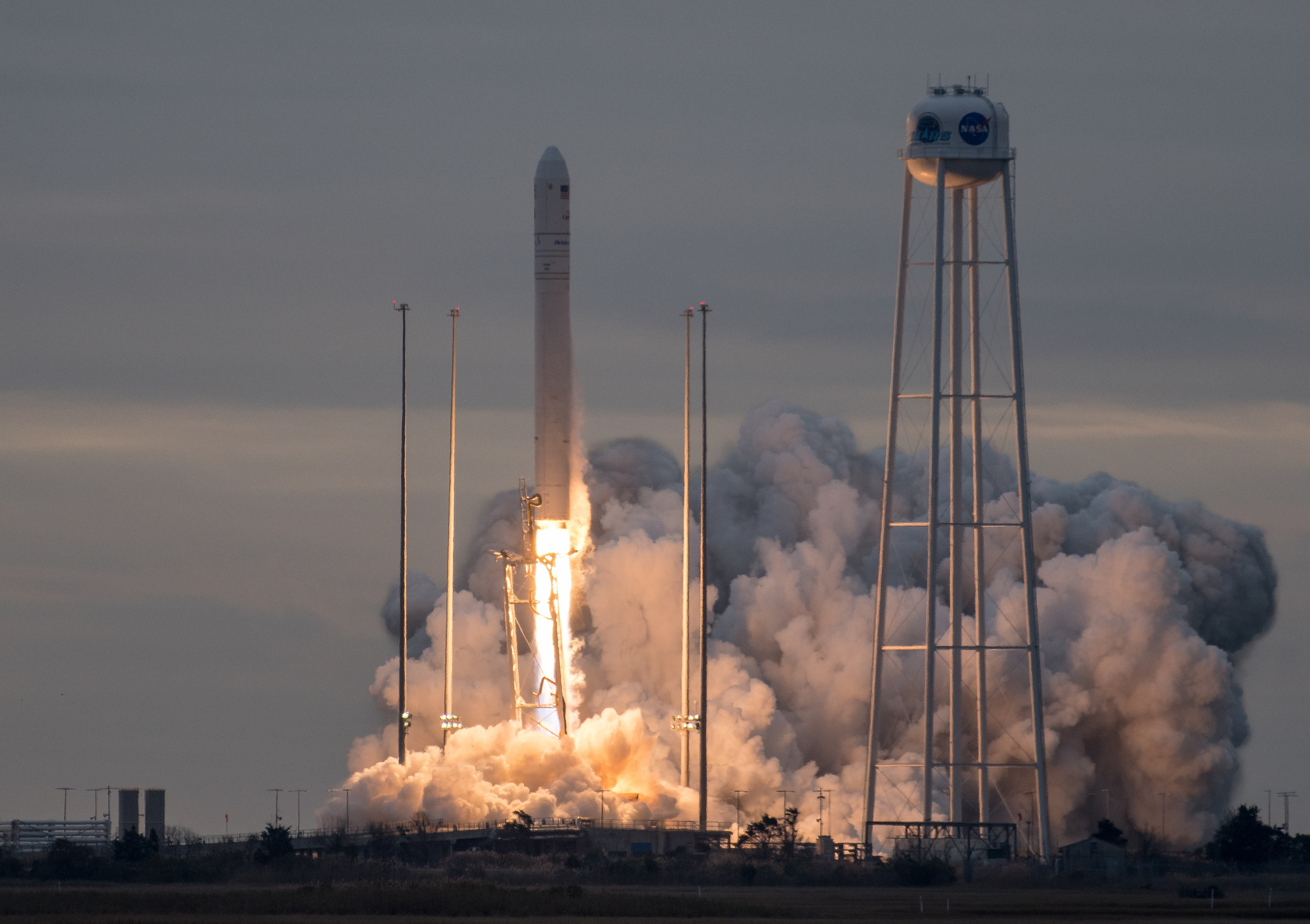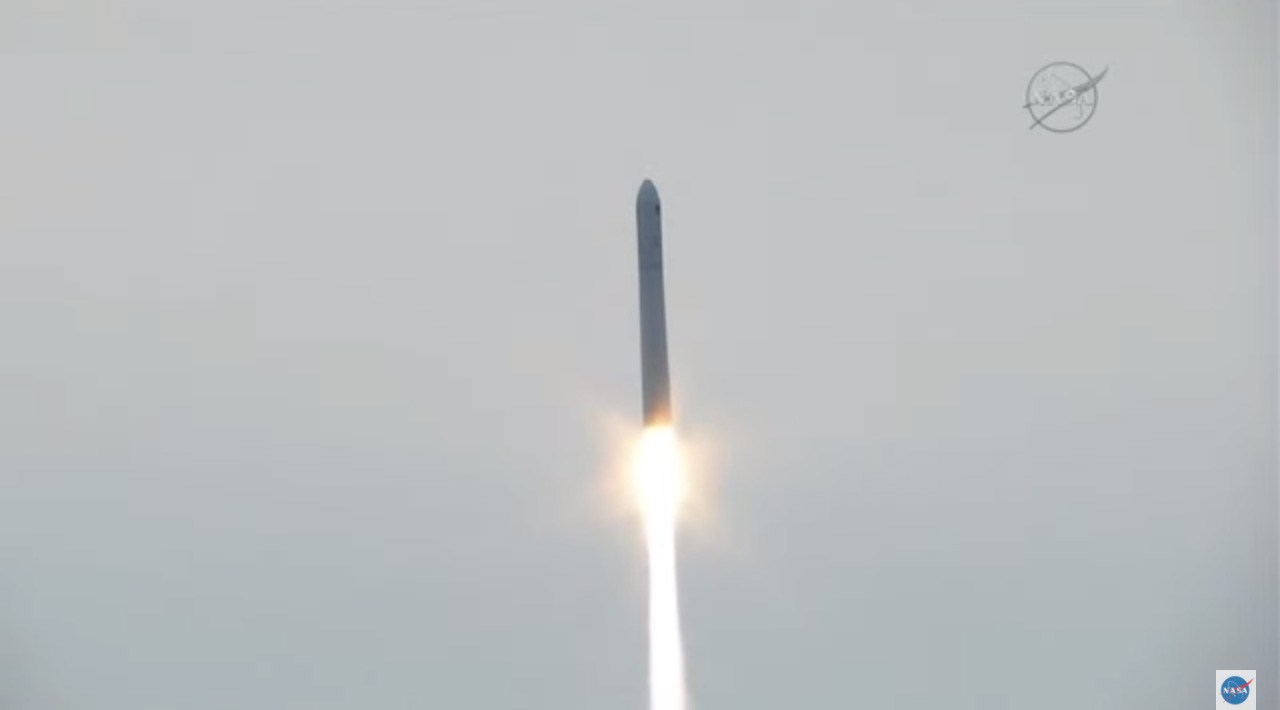Orbital ATK Rocket Launches NASA Cargo to Space Station in Spectacular Morning Liftoff
The commercial spaceflight company Orbital ATK successfully launched an Antares rocket today (Nov. 12), providing a Sunday morning spectacle for early birds along the U.S. east coast.
Topped with the International Space Station-bound Cygnus cargo spacecraft, the 139-foot (42.5-meter) Antares rocket lifted off from NASA's Wallops Flight Facility in Wallops Island, Virginia at 7:19 a.m. EST (1219 GMT). About 9 minutes later, Cygnus was deployed in low-Earth orbit, where it will spend the next two days chasing after the International Space Station (ISS).
"It was great to put a rumble in the air here and to get Cygnus off the ground and on its way to the International Space Station," Dan Hartman, the International Space Station's deputy program manager, said during a post-launch briefing. "It was just a miraculous launch and a flawless countdown." [More Stunning Launch Photos of Orbital ATK's Antares OA-8 Flight]

Antares was originally scheduled to blast off on Saturday (Nov. 11), but it was aborted at the last minute when a small, personal airplane illegally entered the restricted airspace near the launch site. Today, Orbital ATK pushed back the launch time by 5 minutes, from an initial 7:14 a.m. EST (1114 GMT) target, to ensure a pair of boats were outside the restricted area.
During the first launch attempt Saturday, a crowd of 3,500 spectators braved the freezing-cold hours before sunrise to watch the liftoff from NASA's Wallops Flight Facility Visitor Center. A similar crowd size was expected for today's launch. Onlookers could be heard cheering in a NASA broadcast as the Antares rocket fired its engines for liftoff and soared into space.
Packed with supplies and science experiments for the Expedition 53 astronauts, Cygnus is expected to arrive at the ISS Tuesday morning (Nov. 14) at 5:40 a.m. EST (1040 GMT). This 46-hour trip will be the shortest of any Cygnus cargo mission so far, Frank DeMauro, Vice President and General Manager of Orbital ATK's Advanced Programs Division, said during the post-launch briefing. You can watch the rendezvous and docking live here, courtesy of NASA TV.
European Space Agency astronaut Paolo Nespoli will use the Canadarm2 robotic arm to grapple the incoming cargo craft, which is about as big as a cargo van. Orbital ATK dedicated this mission to the late NASA astronaut Gene Cernan, the last person to walk on the moon. This Cygnus spacecraft was named the S.S. Gene Cernan in his honor. [Astronaut Gene Cernan Remembered: Photos of the Last Man on the Moon]
Get the Space.com Newsletter
Breaking space news, the latest updates on rocket launches, skywatching events and more!

Cygnus will deliver about 7,400 lbs. (3,500 kilograms) of food, water, clothing and science equipment to the six crewmembers currently aboard the ISS. About 1,900 lbs. (862 kg), or one-quarter of that cargo will be used for scientific research and technology demonstrations, including a cubesat filled with E. coli that will study antibiotic resistance, a new laser-based communication system, and experiments that will investigate how plants and insects grow in microgravity.
Also aboard the Cygnus cargo ship are some care packages from the astronauts' family members, Orbital ATK officials said. The crew will also receive a special "cool box" filled with fresh fruits and vegetables — a rare treat for the crew, considering they mostly eat prepackaged and freeze-dried packets of special space food and occasional batches of lettuce grown in space.
Some traditional Thanksgiving food items and Christmas gifts are also heading to the space station, Hartman said in the briefing, though he did not offer any specifics on exactly what those goodies might be.
Once the ISS crew completely unpack Cygnus, they'll fill it up with disposable cargo and send it off to burn up in Earth's atmosphere on Dec. 4. That same day, SpaceX plans to launch another cargo resupply mission to the ISS on its Falcon 9 rocket.
Today's cargo launch was the the eighth cargo delivery launch for NASA by Orbital ATK under an initial $1.9 billion agreement between the company and spaceflight company. NASA has since added three more missions to that resupply agreement, and signed a new contract with Orbital ATK for future flights as part of the agency's Commercial Resupply Services 2 program. NASA has also tapped SpaceX (which already flies cargo missions to the space station) and Sierra Nevada Space Systems for delivery services under the CRS-2 program.
Sunday's launch was also the second flight for Orbital ATK's revamped Antares 230 rocket configuration following a launch failure in 2014 that ended in an explosion just seconds after lifting off from the same launch site, Pad-0A, here at NASA's Wallops Flight Facility.
The first launch of the new and improved Antares 230 rocket was the OA-5 cargo resupply mission on Oct. 17, 2016. Orbital ATK has also used United Launch Alliance Atlas V rockets to launch three cargo missions to the ISS since the explosion in 2014.
Email Hanneke Weitering at hweitering@space.com or follow her @hannekescience. Follow us @Spacedotcom, Facebook and Google+. Original article on Space.com.
Join our Space Forums to keep talking space on the latest missions, night sky and more! And if you have a news tip, correction or comment, let us know at: community@space.com.

Hanneke Weitering is a multimedia journalist in the Pacific Northwest reporting on the future of aviation at FutureFlight.aero and Aviation International News and was previously the Editor for Spaceflight and Astronomy news here at Space.com. As an editor with over 10 years of experience in science journalism she has previously written for Scholastic Classroom Magazines, MedPage Today and The Joint Institute for Computational Sciences at Oak Ridge National Laboratory. After studying physics at the University of Tennessee in her hometown of Knoxville, she earned her graduate degree in Science, Health and Environmental Reporting (SHERP) from New York University. Hanneke joined the Space.com team in 2016 as a staff writer and producer, covering topics including spaceflight and astronomy. She currently lives in Seattle, home of the Space Needle, with her cat and two snakes. In her spare time, Hanneke enjoys exploring the Rocky Mountains, basking in nature and looking for dark skies to gaze at the cosmos.









